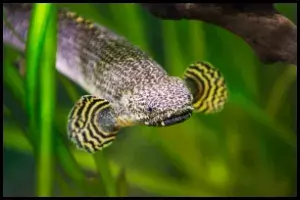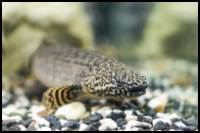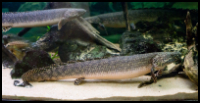




Quick Care Details (Table)
| Livestock Characteristics | Value |
|---|---|
| Care Level | Moderate |
| Temperament | Semi-Aggressive |
| Diet | Carnivore |
| Maximum Size | 1ft & 2 Inches |
| Minimum Tank Size | 90 Gallons |
| Plant Safe | Yes |
| Temperature Range | 74-82F |
| PH Range | 6.2-7.8 |
| KH Range | 5-20 |
Species Specific Categories
Helpful Video
Care Details
Aquascape: When designing an aquarium for the Ornate Bichir, think about replicating its natural habitat. Provide plenty of hiding spots with driftwood, rock caves, and aquatic plants. These structures offer security and mimic the labyrinthine underwater environments they prefer.
Substrate: A sandy or fine gravel substrate is ideal for the Ornate Bichir. They love to explore the substrate, and a softer bottom helps prevent injuries.
Disease Prevention: Regular water changes, a clean environment, and quarantine procedures for new additions can help prevent diseases. Bichirs are quite hardy but still susceptible to common fish ailments.
Filtration: Invest in a powerful filtration system to maintain water quality. Bichirs are sensitive to poor water conditions, and a strong filter will keep their environment pristine.
Lighting: Bichirs don't require strong lighting, and subdued lighting replicates their natural habitat better. It also reduces algae growth and minimizes stress.
Water Flow: These fish don't appreciate strong water currents. Aim for gentle water movement in the tank to mimic their calm waters in the wild.
Hardiness: Ornate Bichirs are hardy fish if kept in suitable conditions. They can tolerate a range of water parameters but prefer stable, warm, and slightly acidic water.
Acclimation: Slow acclimation is crucial when introducing new fish to the tank. Gradually adjust water conditions to minimize stress.
Expected Lifespan: Ornate Bichirs are long-lived fish, with a potential lifespan of 15 to 20 years or more when well cared for.
Special Requirements: These fish are carnivorous, so provide them with a diet of meaty foods like live or frozen options. Additionally, a secure lid is essential for your tank, as Ornate Bichirs are skilled escape artists.
Temperament and Behavior
Behavior: Ornate Bichirs are fascinating creatures with a docile nature. They are primarily nocturnal and spend most of their time hiding among submerged structures. Due to their lung-like organ, they need to surface for an occasional gulp of air. These fish are known for their ancient lineage, dating back millions of years.
Breeding: Breeding Ornate Bichirs can be challenging in a home aquarium due to their secretive nature and the need for distinct breeding conditions. Females lay eggs, which males fertilize externally. It's essential to provide appropriate hiding spots for the eggs and to separate the adults to prevent cannibalism.
Aggression: These fish are not aggressive towards other fish. Instead, they tend to be reclusive and shy, making them a peaceful addition to a community tank. However, they may show cannibalistic tendencies towards smaller tankmates.
Tankmates Compatibility: Ornate Bichirs are best kept with fish of similar size and disposition. Peaceful, non-nippy species that won't outcompete them for food are good choices. Avoid small fish that could become prey.
Activity Level: Ornate Bichirs are generally slow-moving and prefer to stay hidden during the day. They become more active at night when they venture out in search of food.
Schooling or Shoaling Behavior: While these fish may be seen in groups in the wild, they don't exhibit traditional schooling behavior in captivity. They tend to be solitary or may coexist in pairs.
Plant Compatibility: Ornate Bichirs are generally plant-safe. However, they may uproot or disturb delicate plants as they explore the substrate. Sturdier, well-rooted plants are a better choice in a tank with Ornate Bichirs.
Diet and Nutrition
Dry Foods: Ornate Bichirs are primarily carnivorous, so dry foods like pellets and flakes are not their preferred choice. While they might accept them, it's essential to complement their diet with more suitable options.
Frozen Foods: High-quality frozen foods such as bloodworms, brine shrimp, and other meaty treats are excellent choices. These provide the necessary protein and nutrients that these carnivorous fish require.
Live Foods: Live foods are a favorite for Ornate Bichirs. They eagerly consume live feeder fish, ghost shrimp, and small aquatic invertebrates. Offering live foods occasionally can promote natural hunting behaviors.
Vegetables: Ornate Bichirs are not herbivores and typically do not consume vegetables. Their diet should primarily consist of animal-based foods.
Algae: These fish are not known to feed on algae, as they are carnivorous by nature.
Feeding Schedule: Ornate Bichirs are nocturnal feeders and prefer to eat during the night when they are more active. You should offer food once a day, ideally after the tank lights have been turned off.
Supplemental Foods: Besides their primary diet of high-quality frozen and live foods, you can occasionally provide supplemental foods like bloodworms, blackworms, or other protein-rich treats. Variety in their diet helps ensure they receive essential nutrients.
Tank Parameters
Tank Size: Ornate Bichirs are best suited for large aquariums due to their potential size. A tank with a minimum capacity of 75 gallons is recommended. Larger tanks provide more space for these fish to grow and swim comfortably.
Tank Length and Measurements: The tank should be at least 48 inches in length to accommodate the Bichir's elongated body. Depth is also crucial as they can be quite deep-bodied. A tank measuring 48x18x18 inches is a good starting point.
Water Temperature: Ornate Bichirs thrive in tropical water conditions. Maintain a temperature range of 75-82°F (24-28°C) to keep them healthy and active.
pH (Acidity/Alkalinity): Aim for a slightly acidic to neutral pH level between 6.5 and 7.5. Stability in pH is more critical than the exact value.
KH (Carbonate Hardness): A KH level of 6-15 dKH (carbonate hardness) is suitable for Ornate Bichirs.
GH (General Hardness): Keep the GH between 6-12 dGH (general hardness) for these fish.
Hardiness: Ornate Bichirs are generally hardy and can adapt to various water conditions. However, maintaining stable water parameters is crucial to their well-being.
Nitrate (NO3) Levels: It's essential to keep nitrate levels below 20 ppm (parts per million) in the aquarium. Regular water changes and efficient filtration will help achieve this.
History, Popularity, History and Species Variety Details
The History, Popularity and Natural Habitat
History: The Ornate Bichir, known scientifically as Polypterus ornatipinnis, has a fascinating backstory. These remarkable fish originate from the freshwater homes of Central and West Africa. Over the years, they've swum their way into the hearts of aquarium enthusiasts worldwide. Their distinctive looks and ancient charm have made them aquarium stars with a history that dates back in the hobby.
Popularity: Ornate Bichirs are quite the catch in the fish-keeping world. Their unique appearance, featuring those elongated bodies and ornate dorsal fins, never fails to turn heads. While they might not be the most common fish in aquariums, they've got a dedicated fan base among experienced hobbyists who can't resist their quirky charm.
Natural Habitat: In the wild, Ornate Bichirs call the slow-moving rivers, streams, and swamps of Central and West Africa home. These waters are often rich with aquatic plants and create a perfect setting for these fish to thrive. These hardy creatures are adaptable to a range of water conditions, which explains why you can find them in different corners of their native habitat. In their natural environment, they use their unique pectoral fins to gracefully glide through the aquatic vegetation, a mesmerizing sight that showcases their elegance and strength.
Back to topVariations of the Ornate Bichir Fish
- Senegal Bichir (Polypterus senegalus): Often considered the "classic" Bichir, they have a more streamlined appearance compared to the Ornate Bichir. They are smaller and known for their hardiness.
- Gray Bichir (Polypterus retropinnis): These Bichirs have a grayish coloration and distinct pectoral fins, which they use to navigate through their environment.
- Delhezi Bichir (Polypterus delhezi): Named after their unique patterning, these Bichirs are recognized by their striking, maze-like designs along their body.
- Endlicheri Bichir (Polypterus endlicheri): Among the largest of the Bichirs, they can grow to impressive sizes. They have an elongated body and distinct markings.
- Ornatipinnis Bichir (Polypterus ornatipinnis): This is the "Ornate Bichir" known for its intricate fin patterns and regal appearance. It's highly sought after in the aquarium hobby.
- Teugelsi Bichir (Polypterus teugelsi): These Bichirs are notable for their spotted appearance and unique markings.
Back to top
Frequently Asked Questions
Do they have have special water parameter requirements?
They prefer slightly acidic to neutral water (pH around 6.0-7.5), with temperatures between 75-82°F (24-28°C).
Are they prone to any specific diseases?
They can be susceptible to common fish diseases like ich or fin rot. Maintaining a clean and stable environment is key to their health.
Can I breed Ornate Bichirs in my aquarium?
Breeding Ornate Bichirs can be challenging due to their size and territorial behavior. It's best attempted in large, species-specific setups.
Are they hardy fish?
They are hardy fish when kept in optimal conditions, but water quality is crucial. Regular water changes and maintenance are essential.
Can I keep multiple Ornate Bichirs together?
They can be kept in groups but should be closely monitored for any signs of aggression or stress. Provide adequate hiding spots and enough space.
What's their behavior like?
Ornate Bichirs are generally nocturnal and tend to be peaceful towards their own kind. They are slow swimmers and spend much of their time near the tank bottom.
Do Ornate Bichirs need hiding places in the tank?
Yes, they appreciate hiding spots like caves, plants, or driftwood. Providing hiding places helps reduce stress and makes them feel secure.
What should I feed them?
They are carnivorous and thrive on a diet of high-quality pellets, frozen or live foods such as worms, insects, and small fish. Offer a varied diet to keep them healthy.
Are Ornate Bichirs suitable for community tanks?
Ornate Bichirs are generally not recommended for community tanks, as they may prey on smaller fish. They do best in species-specific setups.
What's the ideal tank size for Ornate Bichirs?
A spacious tank is essential. A 75-gallon aquarium or larger is recommended as these fish need room to swim and explore.
How large can Ornate Bichirs grow?
Ornate Bichirs can grow up to 20 inches (50 cm) or more in aquariums. In the wild, they can become even larger.
What is the natural habitat of the Ornate Bichir?
Ornate Bichirs are native to African freshwater environments, particularly the Congo River Basin. They inhabit slow-moving rivers, swamps, and flooded forests.

